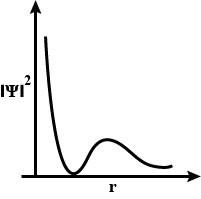
The graph between $|\psi {{|}^{2}}$ and r (radial distance) is shown below. This represents:

A. 3s orbitals
B. 1s orbitals
C. 2p orbitals
D. 2s orbitals

Answer
565.2k+ views
Hint:. These types of graphs are generally known by radial probability distribution curves. These types of curves give us ideas about the electron density at a radial distance from the nucleus. The value of $|\psi {{|}^{2}}$ become zero at a nodal point which can also be known by the name radial node.
Complete step by step answer:
In case of such graphs which are called probability distribution curves tells us about electron density at a radial distance and the type of such graphs i.e. it is of 1s, 2s, 3s etc can be calculated by the number of radial nodes.
Number of radial nodes calculated from the formula $n-l-1$ where n = principle quantum number and $l$represents azimuthal quantum number. Let us take the example of where n = 3 and $l=1$ then the number of radial nodes = $n-l-1=3-1-1=1$; it shows 3p orbital as we know that for p orbital $l=1$.
Now the graph given in the question shows that r touches the axis at one point which means it has only one radial node and at r = 0 it has some value which shows that is it should be for s value and as we known that for s value; $l=0$, then we have to calculate n value as number of radial nodes are 1
$\therefore n-l-1=1$; where $l=0$
Then $\therefore n-0-1=1;n=2$ i.e. given graph is for 2s orbital.
So, the correct answer is “Option D”.
Note: Square of the radial wave function is known by the name radial probability density which gives us probability of finding the electron within the spherical shell enclosed between a sphere of radius $r+dr$ and a sphere of radius r from the nucleus. Radial Probability is generally given by; Radial Probability Density $\times $ Volume of spherical shell = $4\pi {{r}^{2}}d{{R}^{2}}{{n}_{l}}(r)$.
Complete step by step answer:
In case of such graphs which are called probability distribution curves tells us about electron density at a radial distance and the type of such graphs i.e. it is of 1s, 2s, 3s etc can be calculated by the number of radial nodes.
Number of radial nodes calculated from the formula $n-l-1$ where n = principle quantum number and $l$represents azimuthal quantum number. Let us take the example of where n = 3 and $l=1$ then the number of radial nodes = $n-l-1=3-1-1=1$; it shows 3p orbital as we know that for p orbital $l=1$.
Now the graph given in the question shows that r touches the axis at one point which means it has only one radial node and at r = 0 it has some value which shows that is it should be for s value and as we known that for s value; $l=0$, then we have to calculate n value as number of radial nodes are 1
$\therefore n-l-1=1$; where $l=0$
Then $\therefore n-0-1=1;n=2$ i.e. given graph is for 2s orbital.
So, the correct answer is “Option D”.
Note: Square of the radial wave function is known by the name radial probability density which gives us probability of finding the electron within the spherical shell enclosed between a sphere of radius $r+dr$ and a sphere of radius r from the nucleus. Radial Probability is generally given by; Radial Probability Density $\times $ Volume of spherical shell = $4\pi {{r}^{2}}d{{R}^{2}}{{n}_{l}}(r)$.
Recently Updated Pages
Master Class 11 Economics: Engaging Questions & Answers for Success

Master Class 11 English: Engaging Questions & Answers for Success

Master Class 11 Social Science: Engaging Questions & Answers for Success

Master Class 11 Biology: Engaging Questions & Answers for Success

Class 11 Question and Answer - Your Ultimate Solutions Guide

Master Class 11 Business Studies: Engaging Questions & Answers for Success

Trending doubts
10 examples of friction in our daily life

One Metric ton is equal to kg A 10000 B 1000 C 100 class 11 physics CBSE

Difference Between Prokaryotic Cells and Eukaryotic Cells

1 Quintal is equal to a 110 kg b 10 kg c 100kg d 1000 class 11 physics CBSE

Explain zero factorial class 11 maths CBSE

What is a periderm How does periderm formation take class 11 biology CBSE




